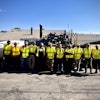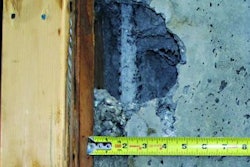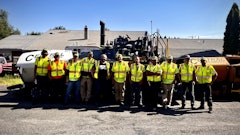New York, NY (September 9, 2011) -- Still reeling from the impact of the recent debt ceiling battle, it's time for Congress and the rest of America to brace themselves for another big battle. It's one that is sure to incite the "no tax under any circumstances" sentiment that has swept the nation courtesy of the Tea Party, and it's one that will have large implications for each of us. On September 30, the federal gas tax, currently at 18.4 cents per gallon, is scheduled to expire. And if it is not renewed, says Barry LePatner, there will be serious implications, not the least of which will be an assured increase in the number of unemployed in this nation.
"Increasing the gas tax to help fund much-needed infrastructure repairs should be common sense," says LePatner, author of Too Big to Fall: America's Failing Infrastructure and the Way Forward (www.TooBigToFall.com). "Unfortunately, as we've seen in Congress recently, common sense does not always rule the day. Those elected officials are already holding an important transportation bill hostage. I fear that a new fight over the federal gas tax will further take our national eye off of the more important goal of remediating our aging and failing infrastructure system."
As reported recently by POLITICO, the expiration of the gas tax may fall prey to the "no tax hike" mantra insisted on by the Republican Party and its Tea Party cohorts. Their outspoken advocate, Grover Norquist, head of the influential Americans for Tax Reform (ATR) group, recently told POLITICO, "In general, ATR has always supported the idea of ending the federal tax on gas and having states pay for their own roads."
"It is imperative that Congress not be scared away from progress by these 'no tax' advocates," says LePatner. "Bottom line, it's time to raise the gas tax."
And here's why. Created in 1956, the federal Highway Trust Fund (HTF) represents the largest source of funding to the states for transportation and road improvements. The HTF is supported largely by the federal gas tax. Over the past fifty years, the gas tax has been increased to meet the growing number of miles in the federal highway system and the increased maintenance costs of the aging U.S. road and bridge program.
However, the gas tax hasn't been increased since 1993 when then-President Bill Clinton increased the tax by four cents to its current rate of 18.4 cents per gallon. In 2008, with the recession taking hold, high gas prices led consumers to stay off the roads. As a result, the HTF was depleted, and Congress had to make an emergency appropriation of an additional $8 billion to keep road maintenance projects throughout the states afloat.
"If the gas tax is allowed to expire on September 30, the nation's transportation system could spiral into its final death throes," warns LePatner. "In fact, it's a very real possibility that without an extension federal and state highway programs will come to a screeching halt. In this environment where a 'no/low tax and decreased government revenues' dialogue seems to disregard the imperatives of failing infrastructure and the impact this can have on our national transportation program, one of our nation's leaders must step up to the plate and effectively acknowledge our great and growing infrastructure needs."
So here are some low/no deficit enhancing ideas that LePatner offers for Congress to ponder as the gas tax deadline looms:
1. Raise the gas tax and reform it to be based on miles traveled. The gas tax hasn't been increased in almost 20 years. "And yet, in that time, we've added more than 100,000 miles of roads," says LePatner. "Many of these new roads have merely added to congestion as the maintenance of other highways, byways, and bridges went unaddressed. With an increase in the gas tax, the Highway Trust Fund will get a new breath of life, and we can begin to address these snowballing maintenance issues."
LePatner also notes that the federal gas tax is not fair for those Americans who do not do a great deal of driving. "The current gas tax is based on usage that is measured by the gallon instead of on the amount of miles driven," explains LePatner. "The introduction of more fuel efficient cars, albeit a good thing, means many drivers are paying less than their fair share for highway maintenance. We need to use the latest technology to more evenly allocate a highway use tax that places more of the burden on those who are the heavy users. One solution that the Congressional Budget Office recently called a 'practical option' would be to tax drivers based on vehicle miles traveled (or VMT) rather than on the amount of gas they use."
2. Create jobs by repairing the nearly 8,000 U.S. bridges in danger of collapse. According to the Federal Highway Administration, we have 7,980 bridges in the U.S. that are both structurally deficient and fracture critical. This means they all are in danger of collapsing just as the I-35W Bridge did in Minneapolis on August 1, 2007. That collapse resulted in the deaths of 13 and injuries to 145. And all it takes is the structural failure of one piece on these nearly 8,000 bridges for them to collapse in much the same way.
"Moving freight across our nation is one of the most critical financial factors affecting our economy," says LePatner. "Nearly 2,000 of these bridges carry more than 10,000 vehicles each day. Massive congestion, estimated to cost nearly $200 billion a year, threatens to choke off our ability to get goods to our rail centers and ports.
"Now consider this: estimates from studies show that every $1 billion of infrastructure investment creates 10,000 to 31,000 jobs. Therefore, if we estimate that each of these bridges can be fixed for an average of $20 million, then with an investment of $40 billion we can create as many as 400,000 jobs that will last for at least two years and avoid future catastrophes. One-third of this expenditure (i.e., $13 billion) will immediately be returned to the federal and state governments via income taxes. The balance will be rotated through the economy as workers spend on food, housing, clothing, and other consumer goods. The net cost to the deficit will be zero."
3. Use only true fixed-price contracts on infrastructure projects. Outrageous cost overruns of 20-40 percent or more (See projects like the Big Dig, Miami Airport, Ground Zero, etc.) can no longer be accepted. "It is time for a major overhaul of the method by which the federal and state governments bid out construction projects," says LePatner. "Requiring contractors to bid with true fixed-price contracts and assume the risk of completing on time and on budget can be incentivized through agreements that pay bonuses for early completion. In addition, better cost analysis by governments and risk management that prices contingencies will end the spiral of cost overruns and save governments billions of dollars annually."
4. Institute the proposed National Infrastructure Bank. Proposals for a National Infrastructure Bank have been around since the idea was originally put forth by U.S. Senators Chris Dodd and Chuck Hagel in 2007. Earlier this year it was renewed when Democratic Senators John Kerry and Mark Warner and Republican Senator Kay Bailey Hutchison offered bipartisan legislation that would create a national infrastructure bank. They propose that the federal government make an initial deposit of $10 billion into the bank. The bank would then become independent and self-sustaining, and the full value of each invested dollar of seed money would be returned to the federal government with interest.
As the Infrastructurist.com explains, "Projects can receive up to 50 percent of their financing from the federal money, but the rest (ideally much more than half) will have to come through private investments. If all goes according to plan, the authority can expect to leverage hundreds of billions in private infrastructure funding over the next several years...The key to the authority's success would be its ability to attract private investors. Initial reports suggest the government's $10 billion seed money could grow to $640 billion inside ten years.
5. Focus on projects in metropolitan areas. As Congress takes up reauthorization of the nation's surface transportation law, they should encourage support for states and cities willing to form a new partnership with the federal government. These partnerships should incentivize metropolitan areas to raise revenues for long-term regional funding of needed projects that will reduce congestion in our 100 largest cities.
"The focus must shift to concentrating on urban areas where two-thirds of our nation's population lives," explains LePatner. "Giving away tens of billions of dollars to politicians to reward campaign contributors with roads to nowhere must end. Only half of all Americans are within reach of mass transit, and this is one area where large returns on investment will prove to be of major value."
6. Increase the use of public-private partnerships (P3s). It is time to actively incentivize private investors to assist in making our failing infrastructure strong again. As federal and state budgets are inadequate for the enormous tasks outlined above, we will need to reach out for the nearly $200 billion in private capital that will be willingly invested if our nation can develop a valid and balanced mechanism for implementing P3s.
"For years these P3 investments have been improving infrastructure all across the globe," says LePatner. "It is long past the time when we should take advantage of the private sector's willingness to take on risk for a fair profit while protecting the public's interest. We can ensure new and needed infrastructure while reaping the long-term benefits of low interest payouts to private funds ready, willing, and able to enter this critical area of need."
"Every one of us must be challenged to take direct responsibility for the decisions that will make a difference in this critical task of rebuilding our nation's infrastructure," says LePatner. "The reality is that Americans know how to build boldly and build well. But we have not done a good job of maintaining what we build. That mindset has reduced our safety, security, and economic strength to a competition between hope and gravity.
"I do not know if our current leaders have the wisdom to see these problems through to the right conclusion," he concludes. "I do not know if they will be brave enough to stand up to the popular, but not necessarily right, 'no tax' sentiment that could end the gas tax and further derail our nation's infrastructure. But I do know that, when it comes to the perilous state of our infrastructure, gravity always wins and failure is no longer an option."


















